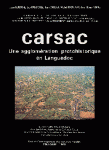Description
À 9 kilomètres à l’Est de Carcassonne, sur la commune de Fontiès-d’Aude, le site dit «La Pièce d’Alquier» a révélé, lors d’une opération d’archéologie préventive conduite en 2010-2011, des occupations de la fin du Néolithique. Une première fréquentation attribuable au Vérazien ancien est matérialisée par une fosse ayant pu être utilisée comme cave ou structure de stockage. Mais l’intervention a surtout mis au jour les témoins d’une occupation campaniforme originale caractérisée par un fossé construit en terre massive. Le mobilier associé, attribuable au Campaniforme pyrénéen, comporte de la céramique décorée ainsi que de la poterie commune caractéristique de ce faciès, une industrie lithique en silex, en quartz et en roches tenaces, enfin quelques témoins métalliques (alênes) et des parures. Ce site est une nouvelle contribution à l’étude de la phase récente du Campaniforme dans le bassin de l’Aude.
Nine kilometres to the East of Carcassonne, in the Fontiès-d’Aude commune, a rescue archeological excavation project carried out in 2010-2011 on a site named « La Pièce d’Alquier » revealed evidence of occupation from the end of the New Stone Age. The first sign of ancient Verazien occupation is materialised by a pit that may have been used as a cellar or a space for storage. But the most significant finding from this excavation was the evidence of an original Bell Beakers occupation caracterised by a ditch made of rammed earth. The associated accessories, attributable to the Pyrenean Bell Beakers culture, includes decorated ceramics as well as plain pottery, a lithic industry in flint, quartz and tenacious rocks, some metallic evidence (awls) and some ornaments. This site is a new contribution to the study of the most recent phase of the Bell Beakers culture in the area of the Aude.




